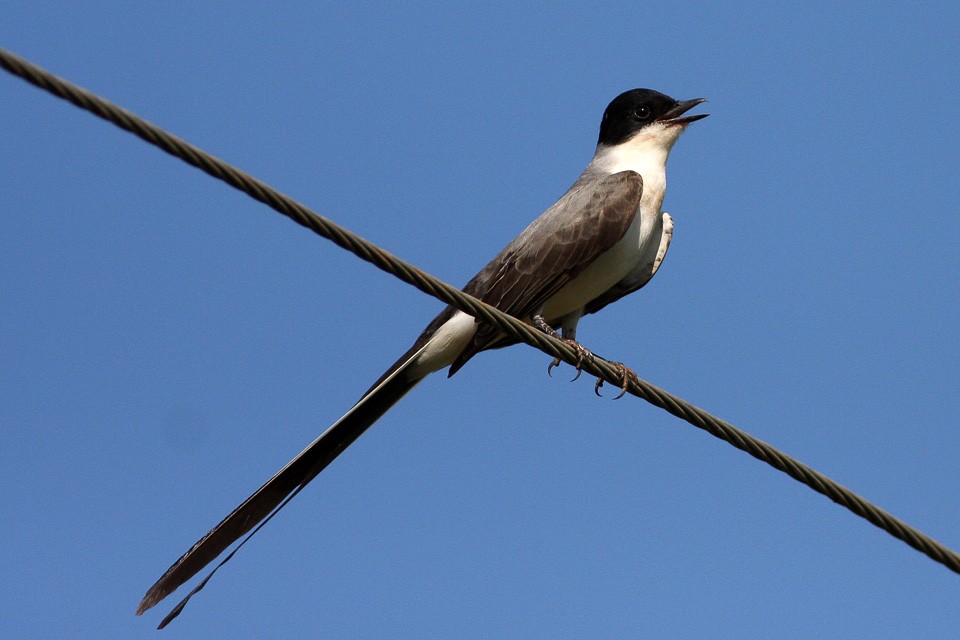Fork-tailed Flycatcher
A species of Kingbirds Scientific name : Tyrannus savana Genus : Kingbirds
Fork-tailed Flycatcher, A species of Kingbirds
Botanical name: Tyrannus savana
Genus: Kingbirds
Content
Description General Info
Description
The fork-tailed flycatcher is white below, gray above, and has a black cap. Males sometimes show a yellow crown stripe. Males also have an extremely long forked tail, of even greater length than that of their cousin, the scissor-tailed flycatcher. Females have a somewhat shorter tail, while it is significantly shorter in juveniles. Males are 37–41 cm (15–16 in) in length; females, 28–30 cm (11–12 in), including tail. They weigh only 28–32 g (0.99–1.13 oz), much less than closely related kingbirds, which are half the total length of this species. The tail in adult males is 2–3 times longer than the length of the bird from the bill to the base of the tail. Generally males and females of the species look quite similar, but can be distinguished by the longer tail in male birds. This species is primarily an insectivore, but will switch to berries and small fruits during winter if insects become scarce. Most Fork-tailed flycatchers are migratory, but some stay year round, especially in southern Mexico. Migratory fork-tailed flycatchers tend to have more pointed wings than non-migratory flycatchers. 
Size
37 cm (14.5 in)
Colors
Brown
Black
Gray
White
Nest Placement
Tree
Feeding Habits
Fork-tailed Flycatcher primarily feeds on flying arthropods, capturing them mid-flight with agile aerial maneuvers. It also supplements its diet with fruit, demonstrating a varied diet. Its unique adaptations for aerial hunting, such as a forked tail for swift, nimble flight changes, aid in capturing prey.
Habitat
Fork-tailed Flycatcher typically inhabits open areas and forest fringes, thriving below 1000 meters elevation, though it can venture up to 2600 meters. Its preferred environments encompass secondary vegetation, savannas, pastures, and suburban spaces such as residential gardens and lawns. Fork-tailed Flycatcher is also found in diverse woodlands, the Brazilian cerrado, mangroves, and during migration, even in tall humid forest canopies. The species exhibits a preference for open cerrado habitats rather than denser forested regions.
Dite type
Insectivorous
General Info
Feeding Habits
Bird food type
Bird Feeder Type

Platform
Sounds
Song
Recording location: Panama
Call
Recording location: Venezuela
Distribution Area
savana (Vieillot, 1808): Central and southern Brazil, Bolivia, Paraguay, Uruguay, and Argentina (south to the Río Negro). Overwinters in Amazonia, a large portion of northern South America (i.e., within the Orinoco River Basin), and Trinidad and Tobago, occasionally appearing in the West Indies. sanctaemartae (Zimmer 1937): Northern Colombia and northwestern Venezuela. circumdatus (Zimmer 1937): Northern Brazil (eastern Amazonas and Pará and Amapá states). monachus (Hartlaub 1844): Southern Mexico and Belize to Colombia, Venezuela, and several offshore islands, Surinam and north-central Brazil. 
Species Status
Not globally threatened.
Scientific Classification
Phylum
Chordates Class
Birds Order
Perching birds Family
Tyrant flycatchers Genus
Kingbirds Species
Fork-tailed Flycatcher 